Impressionism – Discover the French Impressionism Art Movement
Impressionism gave rise to some of art history’s best artists and most loved artworks. The French art movement is commonly associated with some of the biggest names in art history, including Claude Monet and Camille Pissarro. This article will take you through everything you need to know about Impressionism, including famous Impressionist painters and the most iconic pieces of Impressionist art.
Contents
- 1 Impressionism: The Radical Art Movement
- 2 Impressionist Artists
- 3 Top 15 Famous Impressionist Paintings
- 3.1 Le déjeuner sur l’herbe (1863) by Édouard Manet
- 3.2 Olympia (1863) by Édouard Manet
- 3.3 L’atelier de Bazille (1870) by Frederic Bazille
- 3.4 La Classe de Danse (1871 – 1874) by Edgar Degas
- 3.5 Impression, Soleil Levant (1872) by Claude Monet
- 3.6 La Maison du pendu Auvers-sur-Oise (1873) by Paul Cézanne
- 3.7 Bal du Moulin de la Galette (1876) by Pierre-Auguste Renoir
- 3.8 Girl Awakening (1877 – 1878) by Eva Gonzalès
- 3.9 In the Loge (1878) by Mary Cassatt
- 3.10 The Rue Mosnier with Flags (1878) by Édouard Manet
- 3.11 Carnation, Lily, Lily, Rose (c. 1885) by John Singer Sargent
- 3.12 Girl in Rose Dress (1888) by Berthe Morisot
- 3.13 Apple Harvest (1888) by Camille Pissarro
- 3.14 The Water-Lily Pond (1899) by Claude Monet
- 3.15 Spring (1917) by Konstantin Korovin
- 4 From Impressionism to Post-Impressionism
- 5 Frequently Asked Questions
Impressionism: The Radical Art Movement
The story of the radical art movement that paved the way for other revolutionary movements such as post-Impressionism, Cubism, and Fauvism begins with the traditional art academy of France called the Académie des Beaux-Arts. The French academy acted as a kind of reinforcement of the ideals of painting, including technique, style, and representation of classical subject matter such as religious narratives, historical events, and portraits.
The preference of the time or what was considered “good” art was weighed based on the ability of the artist to execute a realistic painting that contained precise brush strokes and the use of color as appropriate to the appearance of the subject.
Sounds quite restricted and boring, does it not? A group of artists, considered radicals of their time, also shared a deep disdain for the ideals promoted by the academy and instead shared a common interest – landscape painting and contemporary subject matter. This was not of interest at the time for jurors of the Salon in Paris, where the ideals of the academy also relied on.

Around the mid-19th century, soon-to-be-famous Impressionists Claude Monet, Alfred Sisley, Frédéric Bazille, and Pierre-Auguste Renoir joined values and began their own little club, often venturing out on their own to paint together. What did they do differently? This small group of Impressionists painted directly in the open air, without any preliminary sketches to prepare for detailed paintings. This may seem like a natural experiment for any artist at present but for the professionals of the 19th century, this was careless and unprofessional. The artists also chose to incorporate vivid synthetic colors, which were also introduced mid-century.
Impressionist gatherings were commonly held at Café Guerbois in Paris and included long talks hosted by none other than Édouard Manet, who strangely enough never partook in any Impressionist exhibitions of the time.
Later on, the group of artists received many other admirers such as Paul Cézanne and Camille Pissarro. Throughout the 1860s, the Impressionists faced many rejections from the Salon, who even rejected Manet’s The Luncheon on the Grass (1863), which depicted a realistic nude woman at a picnic accompanied by two fully-clothed men. The inclusion of a nude woman in a contemporary scene was heavily condemned.
An Impressionism Definition
So, what is Impressionism? When collating an Impressionism definition, one must understand that the composition of Impressionist painting was characterized by the lack of boundaries between the background and subject of an artwork. Impressionism can be understood as a snapshot or moment of a broader reality taken by chance.
Impressionist artists used open compositions and visible brush strokes, and accentuated the depiction of light to highlight the passage of time through unusual perspectives and techniques to illustrate movement.
A Response to Photography
As photography became more popular and more readily portable, which meant that the idea of reproducing reality became easier. This was also a kind of a threat to artists but for the Impressionists, it served as means by which the artist can be distinguished from the photographer. Instead of competing with the camera, the Impressionists gave the public a subjective rendition of the world as they saw it.
The representation of perception, as opposed to reality, is what made Impressionist art unique.
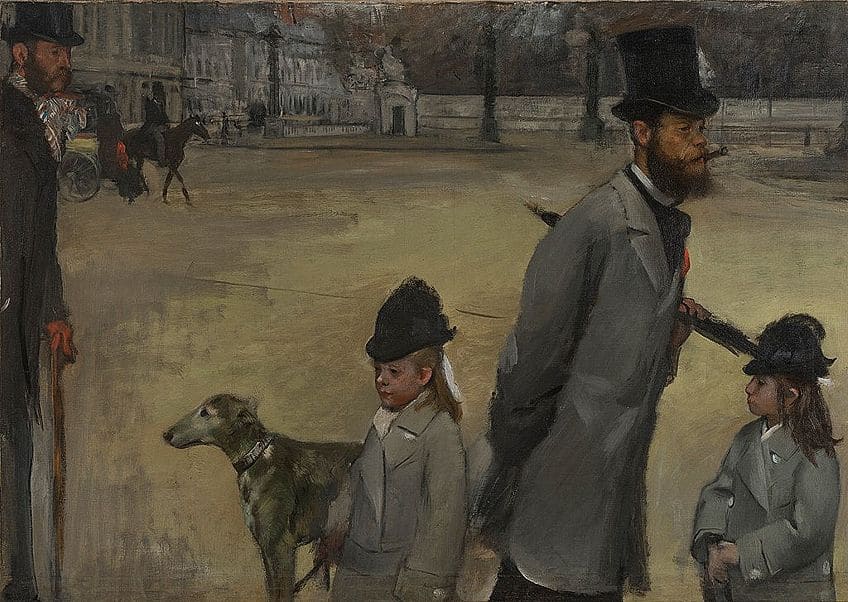
The angles expressed in many paintings of French Impressionism were also influenced by the Japanese art form called Japonism found in ukiyo-e prints. The work of Edgar Degas clearly illustrates the influence of this art form through asymmetrical compositions and unusual amounts of space, as seen in his painting La classe de danse (1874).
The Salon des Refusés
The Salon of the refused emerged due to the high number of rejections seen at the Salon. This was established by Emperor Napoleon III so that the public would be able to offer their judgment on the rejected works. Although the rejected works became a laughing stock to the public and a place of mockery, the Salon des Refusés received more visitors than the Salon. Artists continued to petition for another Salon des Refusés exhibition to be held, but they too were rejected.
Born out of rejection and as you might imagine, some with bruised egos and damaged reputations, a new society emerged for the acceptance of Impressionism.

This group called themselves the Société Anonyme Coopérative des Artistes Peintres, Sculpteurs, et Graveurs and was founded in 1873 by Claude Monet, Edgar Degas, and many other artists. Requirements for entry into the association required that artists renounced their participation in the Salon.
The primary technique associated with Impressionism was called the en plein air technique and involved the artist painting without any preparation or sketches.
Impressionism was therefore an impression of a scene at the moment. An art critic by the name of Louis Leroy also remarked on Monet’s Impression, Sunrise (1872) painting as being more of a sketch than a finished artwork and that wallpaper, “in its embryonic state was more finished than the seascape”. You sure had to have tough skin to survive the art critics of the 19th century.
Agree to Disagree
The Impressionists may have created their collective of sorts for the acceptance of broader expressions in painting and technique but there was also a rejection of the ideals of Impressionism by artists like Degas, Manet, and Renoir. At some point, Renoir left the association completely.
Manet chose to stick to his own principles in painting by retaining his use of the color black while the others preferred the predominant theme of Impressionism that was pursued through spontaneity, sunlight, and color.
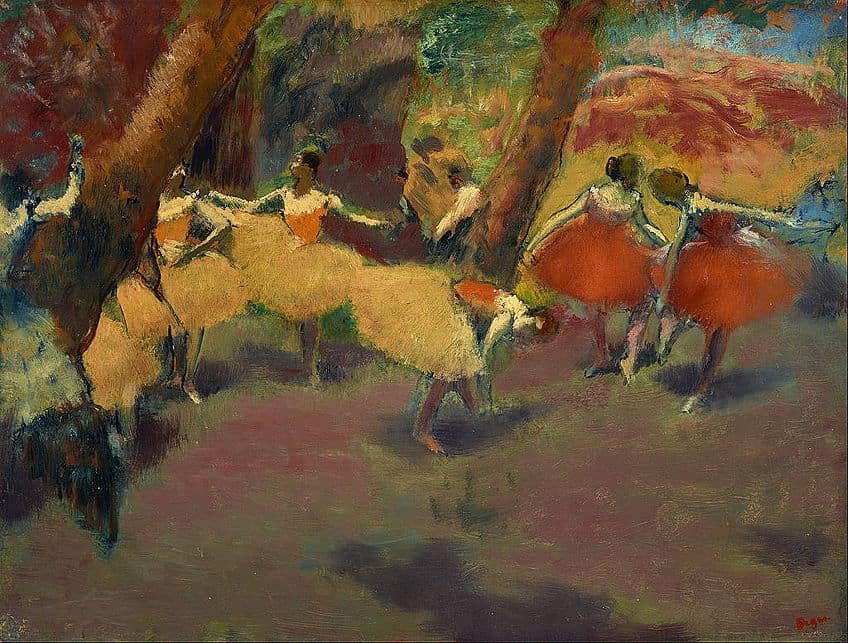
Manet also never actually partook in any of the Impressionist exhibitions since he believed that persevering at the Salon would have been better. Over time, the group dispersed and many returned to submit their artworks for consideration at the Salon.
Artists who “defected” from the original Salon des Refusés were Monet, Cézanne, Sisley, and others. Despite the divided nature of the group at this point, there were more defectors to follow.
Mary Cassatt also received an invitation from Degas to showcase her work at the 1879 exhibition and she took this opportunity to insist that other artists such as Ludovic Lepic and other realist painters be included. Monet’s reaction to the additional parties caused an uproar in 1880 and he accused the group of letting “first-come daubers” into the group. Further division was created when it came to the consideration of adding Georges Seurat and Paul Signac to the repertoire in 1886.
Impressionist Artists
The French Impressionists of the 1880s are said to have created their definition of Impressionist art through both their process of acceptance and rejection of whose artworks were included and “considered” for the Impressionist exhibitions.
Camille Pissarro, the Danish-French Impressionist was the only “founder” of Impressionism who exhibited his works in all eight Impressionist exhibitions.
So, how can we form an Impressionism definition? First, we must look at the characteristics of Impressionism found in the Impressionist art of the founders. Below, we will highlight a few characteristics found in the art of famous Impressionist painters.
Camille Pissarro (1830 – 1903)
| Artist Name | Jacob Abraham Camille Pissarro |
| Date of Birth | 10 July 1830 |
| Date of Death | 13 November 1903 |
| Nationality | French, Danish |
As a key contributor to both the Impressionist and post-Impressionist movements of the late 19th century, Camille Pissarro was not only the only member of the Impressionist group to exhibit at all their exhibitions but he was also considered to be the pillar of the group. Dubbed the “Dean of the Impressionists”, the “kind-hearted” Pissarro also received a great deal of criticism for his works often being described as “vulgar”.
Impressionist paintings, as executed by Pissarro and many other French Impressionists were executed in one sitting by painting “wet on wet”.

Edgar Degas (1834 – 1917)
| Artist Name | Hilaire-Germain-Edgar De Gas |
| Date of Birth | 19 July 1834 |
| Date of Death | 27 September 1917 |
| Nationality | French |
Edgar Degas was one of the key influential members of the French Impressionist movement and captured his subjects beautifully through pastel drawings and oil painting. Degas was also a highly skilled printmaker, who later collaborated with Mary Cassatt for the rest of his days.
Initially, Degas wanted to become a painter who specialized in history, like a historical painter, but as he approached his thirties, he shifted towards becoming a classical painter of modernity.

Degas reflected the style of Impressionism through softness in the depiction of dancers and vibrancy and movement in the depiction of scenes with still-life objects. Degas also experimented with light and shadow most often when portraying performers and concert scenes.
Oscar-Claude Monet (1840 – 1926)
| Artist Name | Oscar-Claude Monet |
| Date of Birth | 14 November 1840 |
| Date of Death | 05 December 1926 |
| Nationality | French |
Known as the founder of French Impressionism, Claude Monet provided the rest of the art world of France with the art movement that paved the way for creative thinking away from the ideals of the academy and toward Modernism. In many of Monet’s works, you will find the ideals of Impressionism itself.
Monet focused very much on the representation of natural landscapes and scenes from his everyday life. The defining characteristics that make his work Impressionist can be seen in his painting style and use of color.
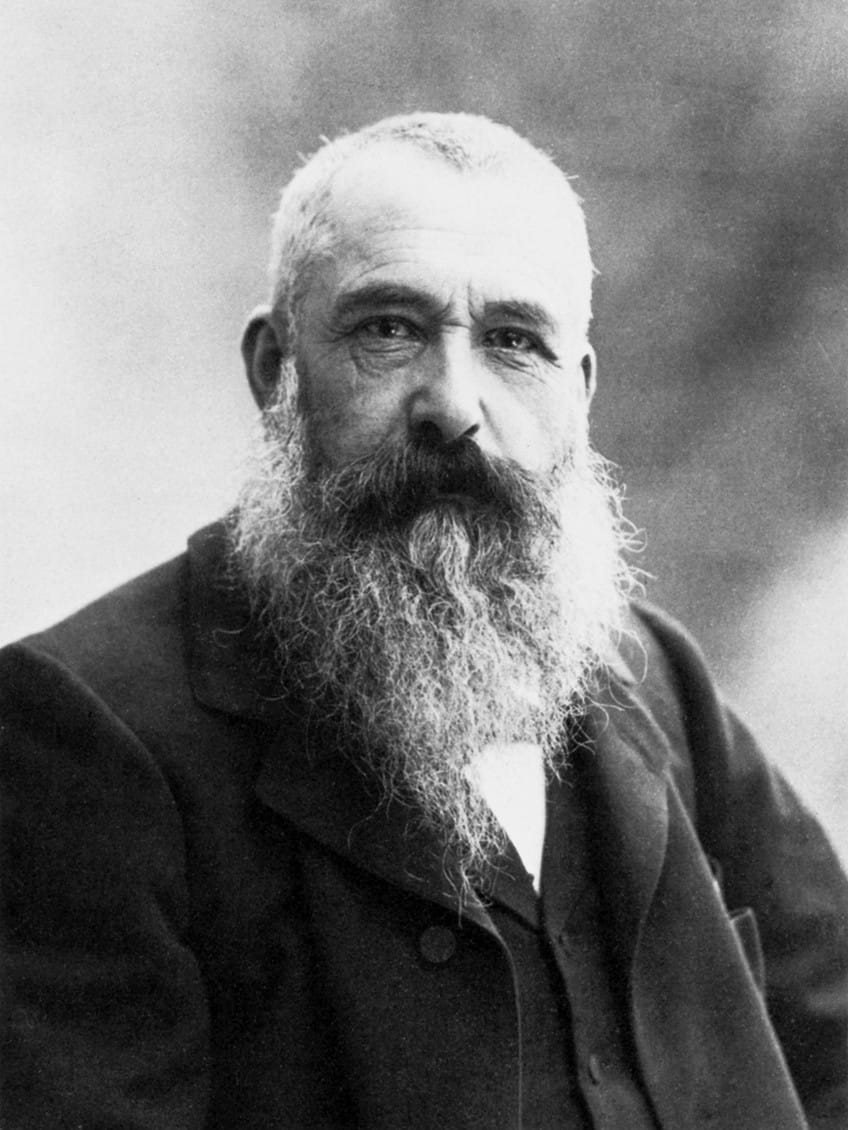
Monet loved to paint natural scenes, especially scenes with water because it allowed for a play with light, reflection, and interesting use of color to draw attention to the moment. Around the 1860s, Impressionists like Monet began to paint on canvases that were prepared with a reddish-brown or gray ground for the scene and by the 1870s, the transition to lighter colors was seen in his choice to use a light beige and eventually an off-white.
For Impressionist paintings, this meant that the color of the ground was no longer of importance when it came to ensuring a finished painting.
Many of his famous series such as the hay stacks (1890-1891) and his garden water lily series, which occupied the last two decades of his life showcased the Impressionist techniques, with a focus on light, changing seasons, and the French countryside. Over the years, Monet gained many followers and admirers of his style and is today known as the father of Impressionism.
Mary Stevenson Cassatt (1844 – 1926)
| Artist Name | Mary Stevenson Cassatt |
| Date of Birth | 22 May 1844 |
| Date of Death | 14 June 1926 |
| Nationality | American |
Mary Cassatt was an American Impressionist painter who frequented the company of the French Impressionists, including Edgar Degas. Her subject matter revolved around the intimate moments of the social lives of women and the relationship between the mother and her children.
After establishing herself as a firm disbeliever of the Salon and the measures that a female artist had to take to get her work exhibited in the Salon, Cassatt joined the Impressionists.

Many of Cassatt’s works exhibit the classic impasto technique involving thick layers of paint in painting and short brush strokes to capture detail, texture, and depth.
Top 15 Famous Impressionist Paintings
When looking at the idea of Impressionism and forming an Impressionism definition, it is useful to not only examine the art styles and characteristics of Impressionist art but it is equally as important to unpack the paintings that received the most attention. Anyone can recreate an impression en Plein air but only true Impressionists can leave a long-lasting impression. To truly form your Impressionism definition, below is a list of the most famous Impressionist paintings.
Le déjeuner sur l’herbe (1863) by Édouard Manet
| Artist | Édouard Manet (1832 – 1883) |
| Date | 1863 |
| Medium | Oil on canvas |
| Dimensions (cm) | 208 x 264.5 |
| Where It Is Housed | Musée d’Orsay, Paris, France |
Never has a painting seen that much rejection in art history, this painting by Édouard Manet was criticized as vulgar by the jurors of the 1863 Salon in Paris. The painting was meant to serve as a tribute to the European art heritage, inspired by Titian’s Concert Champêtre (1509).
Manet later exhibited the painting under a different title, Le Bain, at the Salon des Refusés, where it attracted a significant amount of mockery.
Why was this painting so heavily criticized? you may wonder. The painting’s composition was considered to be a contemporary scene since it neither had a direct reference to mythological or allegorical elements but contained a nude woman with clothed men at a picnic, which seemed ridiculous for the viewers back in the day. The painting was considered obscene and unrealistic, even receiving the nickname La partie carrée.
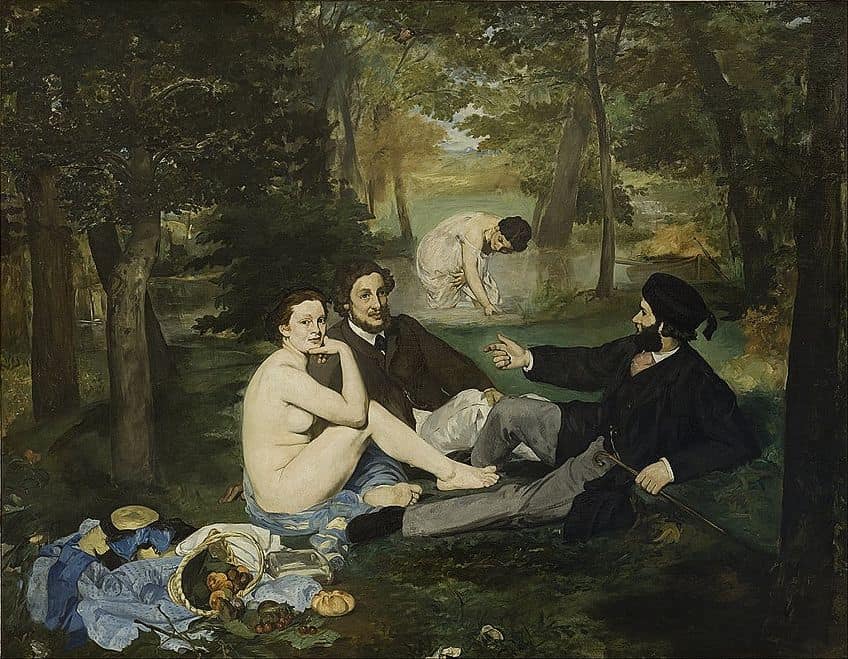
One can also say that Manet’s Le déjeuner sur l’herbe also presented some modern elements seen in his negation of gradation and high-contrast elements, which the public was unprepared for. The subjects in the painting also seem unusually uncomfortable and squished into the composition.
Manet also left out any sense of perspective or depth and therefore highlights his aversion to conformity.
Olympia (1863) by Édouard Manet
| Artist | Édouard Manet (1832 – 1883) |
| Date | 1863 |
| Medium | Oil on canvas |
| Dimensions (cm) | 190 x 130 |
| Where It Is Housed | Musée d’Orsay, Paris, France |
Manet also caused quite the stir at the Salon with Olympia, executed in the same year as the previous painting, Le déjeuner sur l’herbe. As you might expect, this painting of a nude woman shook the art critics and jurors of the 1865 Salon just as much as the nude woman in a picnic. It is as if Manet had to plan which painting to shock the viewers with first.
For Olympia (1863), Manet utilized multiple historical references, including Venus of Urbino (1534) by Titian.
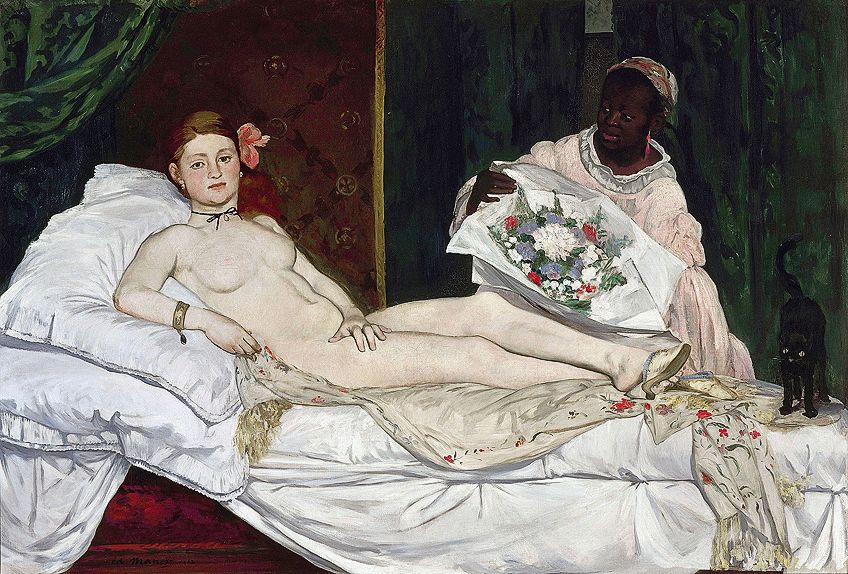
Olympia is not just a “vulgar” image of a nude woman whose gaze pierces the viewer. Olympia showcases a very contemporary scene of a woman who is thought to have received flowers for her beauty and potentially, her sexual services.
The irony of the nude woman is evident since the female nude was often featured in many academic paintings but none so admittedly in nature as that of Manet’s Olympia.
L’atelier de Bazille (1870) by Frederic Bazille
| Artist | Jean Frédéric Bazille (1841 – 1870) |
| Date | 1870 |
| Medium | Oil on canvas |
| Dimensions (cm) | 98 x 128.5 |
| Where It Is Housed | Musée d’Orsay, Paris, France |
Specializing in figure painting, this French Impressionist painter created L’atelier de Bazille in the same year as his tragic death in the Franco-Prussian war of November 1870. Another famous work housed at the Musée d’Orsay is The Pink Dress (c. 1864), which he created at the young age of 23. L’atelier de Bazille was the artist’s art studio and is known to be his best masterpiece depicting many pivotal artists of the Impressionist movement, including Monet, Emile Zola, Manet, Renoir, and Edmond Maître.
A wealthy man, Bazille was admired for his generosity to his associates by allowing them to work in his large studio.
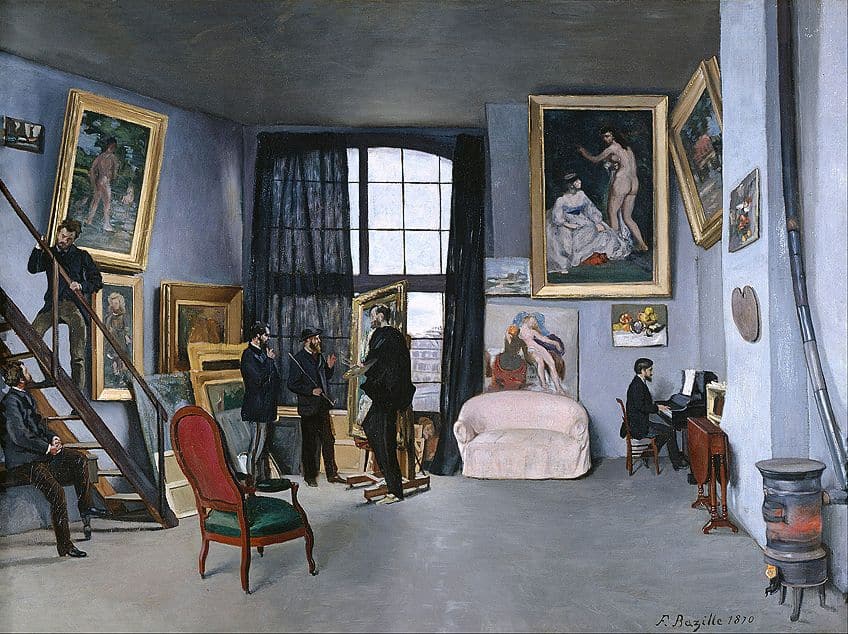
La Classe de Danse (1871 – 1874) by Edgar Degas
| Artist | Edgar Degas (1834 – 1917) |
| Date | 1871 – 1874 |
| Medium | Oil on canvas |
| Dimensions (cm) | 75 x 85 |
| Where It Is Housed | Musée d’Orsay, Paris, France |
Also housed at the Musée d’Orsay in Paris, La Classe de Danse is a famous Impressionist painting by Edgar Degas, painted between 1871 and 1874. Unlike other Impressionists, Degas placed importance on the ground and this can be seen in his use of perspective in Le Classe de Danse.
The vanishing point can be seen on the studio floorboards with an elevated overview of the distant diagonal expanse of the studio.
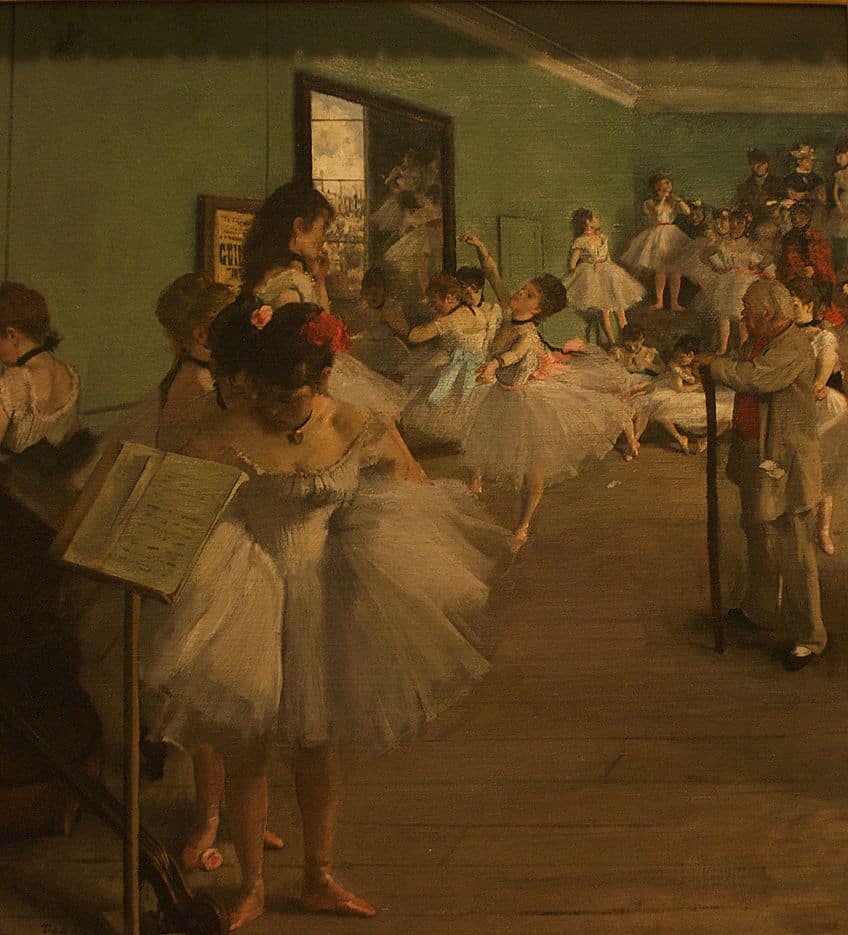
Degas frequented the studio and backstage of the Paris opera house since he also had a friend in the orchestra. Degas is most famous for his paintings of ballerina dancers and their different preparation scenes, whether it was in the studio or at rest, Degas was interested in the life of the ballerina, the dancer, and the body in training for such a strenuous art form.
Impression, Soleil Levant (1872) by Claude Monet
| Artist | Claude Monet (1840 – 1926) |
| Date | 1872 |
| Medium | Oil on canvas |
| Dimensions (cm) | 50 x 65 |
| Where It Is Housed | Musée Marmottan Monet, Paris, France |
Impression, Sunrise (1872) by Claude Monet is perhaps the most famous Impressionist painting recognized as being the first formal submission made by Monet, the father of Impressionism himself. The rising sun is illustrated in a burning orange blob of oil paint situated among the cool-toned pastel blues, greens, purples, and orange hues.
This masterwork, which depicted Monet’s view of Le Havre, was once heavily criticized by art critics as appearing unfinished.
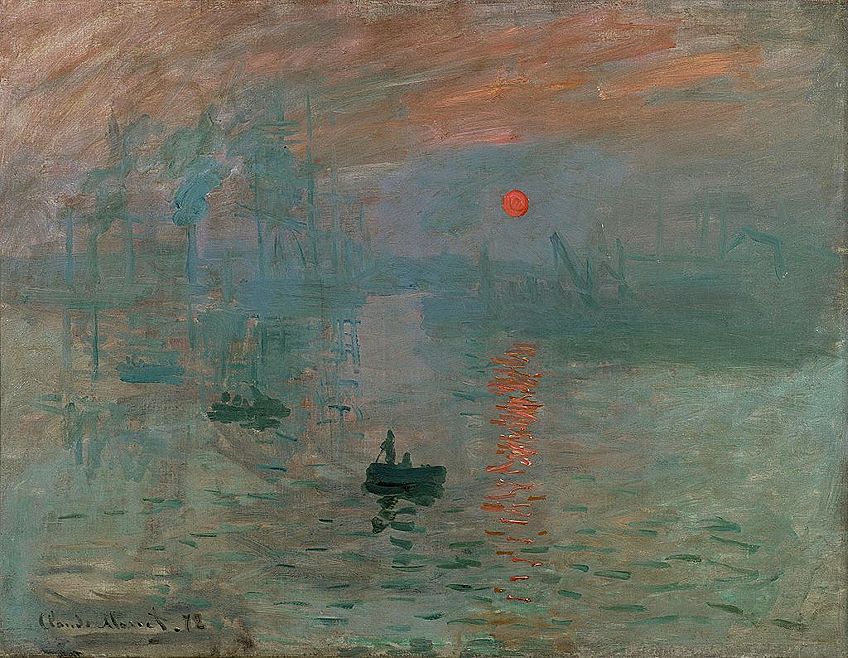
The artwork also became a joke to those who preferred the ideals of academic painting. The painting was completed in just a few hours and was also included in the first exhibition for the Société Anonyme Coopérative des Artistes, Peintres, Sculpteurs, Engraveurs, et Lithographes in 1874.
La Maison du pendu Auvers-sur-Oise (1873) by Paul Cézanne
| Artist | Paul Cézanne (1839 – 1906) |
| Date | 1873 |
| Medium | Oil on canvas |
| Dimensions (cm) | 55.5 x 66.3 |
| Where It Is Housed | Musée d’Orsay, Paris, France |
While the art of Paul Cézanne is often classified under post-Impressionism, several works from the 1870s showcase his brief use of Impressionism. The landscape above, La Maison du pendu Auvers-sur-Oise (1873) translates to the house of the hanged man, which is a fairly dark title for a seemingly innocent Impressionist landscape. This painting was one of three other artworks exhibited at the Impressionist group show in 1874 and was bought by Count Armand Doria.
Cézanne was known for creating his style with a knife. Cézanne quickly exited the realm of Impressionism to pursue bolder and more modern Cubist styles.

Bal du Moulin de la Galette (1876) by Pierre-Auguste Renoir
| Artist | Pierre-Auguste Renoir (1841 – 1919) |
| Date | 1876 |
| Medium | Oil on canvas |
| Dimensions (cm) | 131.5 x 176.5 |
| Where It Is Housed | Musée d’Orsay, Paris, France |
Bal du Moulin de la Galette (1876) is one of Renoir’s most important paintings and one of the world’s most famous Impressionist artworks illustrating 19th-century Parisian life. Exhibited in 1877, this bubbly painting showcases the joyous atmosphere at a very popular dance garden around the Butte Montmartre. Renoir’s painting makes use of vivid brush strokes coupled with artificial and natural lighting found in the movement of the crowd.
The blurred nature of the scene, as with many Impressionist paintings, garnered negative criticism from art critics.
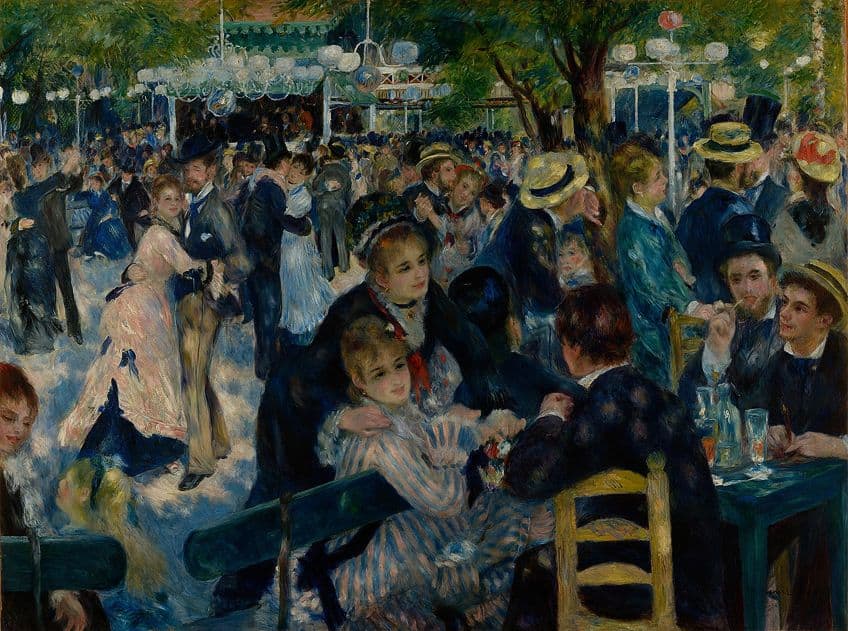
Girl Awakening (1877 – 1878) by Eva Gonzalès
| Artist | Eva Gonzalès (1849 – 1883) |
| Date | 1877 – 1878 |
| Medium | Oil on canvas |
| Dimensions (cm) | 81.1 x 100.1 |
| Where It Is Housed | Kunsthalle Bremen, Bremen, Germany |
Not as publicized as much but still one of the most famous female Impressionist paintings, Girl Awakening (c. 1877 – 1878) by Eva Gonzalès, who was also Manet’s first female student. Gonzalès’ use of pastel colors and the medium itself was spectacular and caught the attention of the Salon as early as the 1870s.
The painting above showcases a woman resembling the artist’s sister, Jeanne, who often modeled for her sister and later married her husband, Henri-Charles Guérard, who was also acquainted with Manet.
Unfortunately, Eva Gonzalès passed away after the birth of her son just four years after marrying. Girl Awakening illustrates a young woman with stark black hair and delicate white skin who seems to have just awoken from sleep. This soft and intimate image was executed brilliantly by Gonzalès and is an excellent display of her insight into the smallest details of a woman’s life in 19th-century Paris.
In the Loge (1878) by Mary Cassatt
| Artist | Mary Stevenson Cassatt (1844 – 1926) |
| Date | 1878 |
| Medium | Oil on canvas |
| Dimensions (cm) | 66 x 81 |
| Where It Is Housed | Museum of Fine Arts, Boston, United States |
One of Mary Cassatt’s first themes in her Impressionist paintings were of the theater, which was a well-known destination for entertainment in 19th century Paris. Cassatt tended to focus on the spectator in theater as opposed to the performers onstage, which were the focal subjects of her contemporary, Degas’ work. In the Loge (1878) shows us a spectator engaged in the act of spectating while being watched by another man in the distance.
The subject of the glance and observation in a setting of observation is what makes Cassatt’s painting stand out. The woman is presented as both the object of the man’s desire as well as her social freedom as a modern woman.
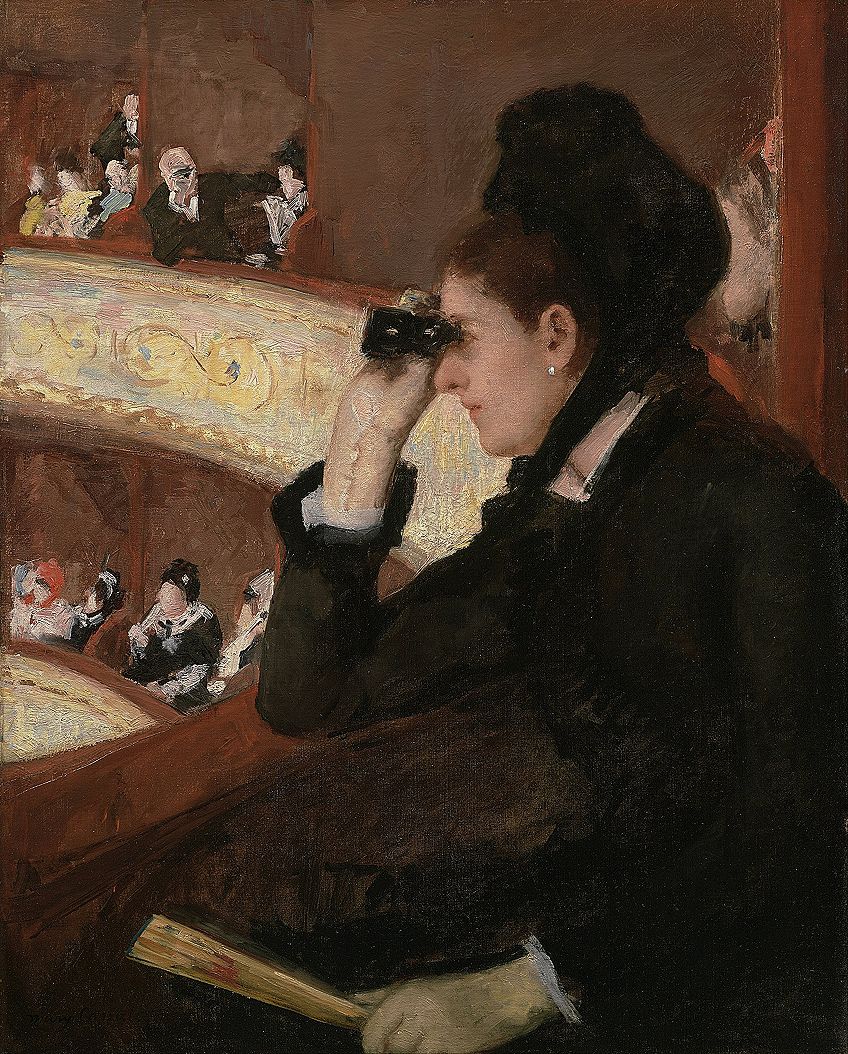
The Rue Mosnier with Flags (1878) by Édouard Manet
| Artist | Édouard Manet |
| Date | 1878 |
| Medium | Oil on canvas |
| Dimensions (cm) | 65.4 x 80 |
| Where It Is Housed | The J. Paul Getty Museum, Los Angeles, United States |
Another subject explored in Impressionist art was the emergence and expansion of the Industrial era and its impact on society. Manet painted The Rue Mosnier with Flags (1878) from his second-story window showcasing the celebration of peace on June 30, 1878, which was a national holiday for the celebration of the Exposition Universelle.
The painting exudes rich hues reflected by the French flags hanging from the windows of the new building.
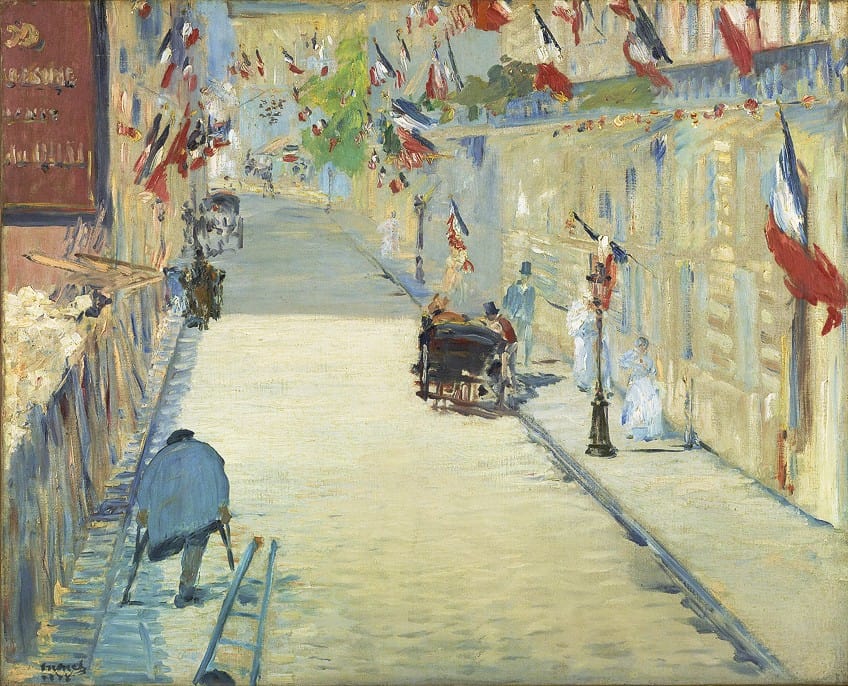
The depiction of streets was also a popular subject of Impressionist artworks and Manet beautifully captured many people in the painting, including the passengers in the cabs, an amputee with crutches, and a worker holding a ladder. Manet also pays close attention to detail by illustrating debris left in the wake of the construction of the new railway.
This also highlights his knowledge of the sacrifices associated with national pride.
Carnation, Lily, Lily, Rose (c. 1885) by John Singer Sargent
| Artist | John Singer Sargent (1856 – 1925) |
| Date | c. 1885 |
| Medium | Oil on canvas |
| Dimensions (cm) | 153.7 x 17.4 |
| Where It Is Housed | Tate Britain, London, United Kingdom |
Derived from a popular song by Joseph Mazzinghi, The Wreath, John Singer Sargent created Carnation, Lily, Lily, Rose around 1885 as an impression of the light that illuminated from dusk. Sargent was a pioneer of American portraiture painting, an expatriate, and a talented landscape artist of his time.
Although not part of the group of French Impressionists, the American expatriate was friends with Frederick Barnard, an illustrator whose children are the subject in Sargent’s painting.
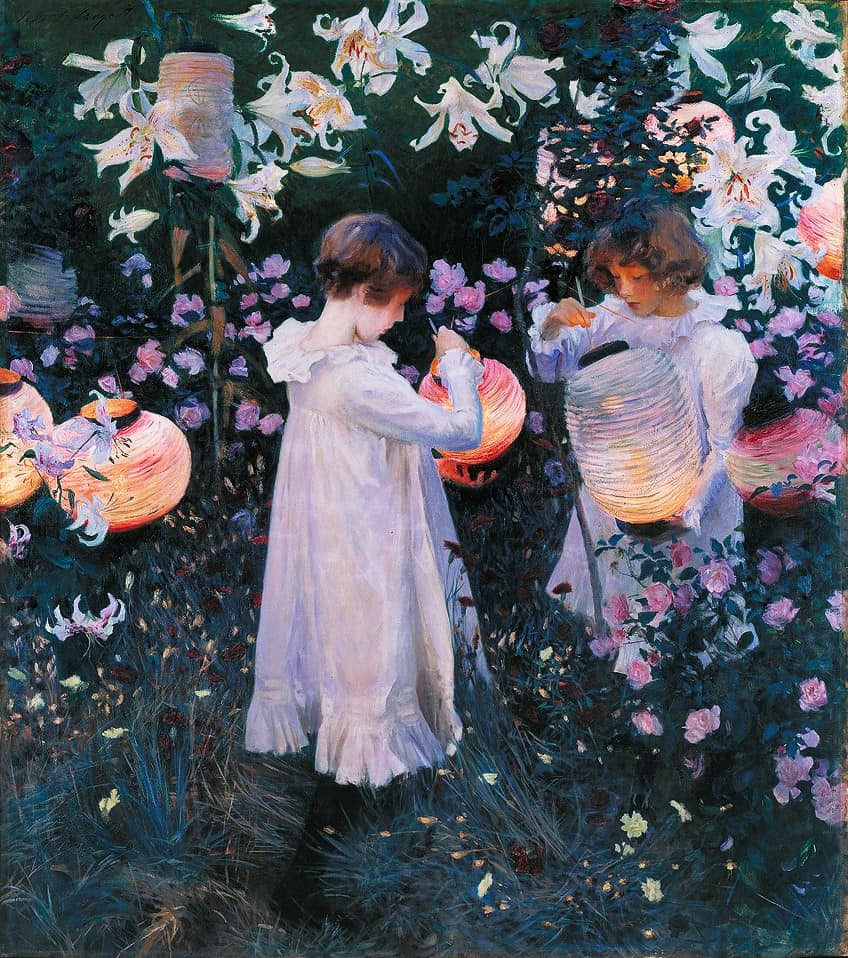
The children, Dolly and Polly, are captured lighting Japanese lanterns using tapers. Sargent was also acquainted with Degas and Monet at one point in his career via his friendship with the French painter Paul César Helleu. You may also associate the American painter with the controversial painting of Portrait of Madame X in 1884.
Girl in Rose Dress (1888) by Berthe Morisot
| Artist | Berthe Marie Pauline Morisot (1841 – 1895) |
| Date | 1888 |
| Medium | Oil on canvas |
| Dimensions (cm) | 81.5 x 51.3 |
| Where It Is Housed | Tokyo Fuji Art Museum, Tokyo, Japan |
While not many women in Impressionism have been documented, Berthe Morisot was a frequent Salon exhibitor and prolific Impressionist of the 19th century. Morisot joined hands with the Impressionists in 1874 and exhibited alongside other big names like Claude Monet and Camille Pissarro.
The artist was also the sister-in-law of Édouard Manet and was described as les trois grandes dames of Impressionism along with the likes of other prolific female Impressionists such as Mary Cassatt and Marie Bracquemond.
Morisot was also the only painter to convince Manet to begin en Plein air painting. In her work, Girl in Rose Dress (1888), Morisot skillfully incorporates bright colors on the young girl who is wearing a rose-colored dress. Morisot’s paintings were often left unfinished on the edges of the canvas and heightened the movement and spontaneity associated with her style.
Throughout her work, Morisot explored short and quick brush strokes as well as long elegant brush strokes that added definition and a modern form to her subjects.
Apple Harvest (1888) by Camille Pissarro
| Artist | Camille Pissarro (1830 – 1903) |
| Date | 1888 |
| Medium | Oil on canvas |
| Dimensions (cm) | 73.9 x 60.9 |
| Where It Is Housed | Dallas Museum of Art, Dallas, United States |
Camille Pissarro received artistic inspiration from his predecessors Jean-Baptiste-Camille Corot and Gustave Courbet, including his contemporaries, such as Georges Seurat. Recognized as the dean of the Impressionists and admired by the likes of both Paul Gauguin and Paul Cézanne, Pissarro was also a leader in technique defined by Neo-Impressionism.
In Apple Harvest (1888), Pissarro is seen using a technique called pointillism, which is characterized by the use of microdots placed so closely together that it creates the illusion of blended color and defined features.

This decorative technique is showcased brilliantly in Apple Harvest through a mixture of lavender, green, orange, yellow, red, blue, and pink hues to depict the French countryside and the apple pickers in it. Pissarro was a master but by age 54, he was still open to adapting and using innovative techniques like Pointillism to evolve his style.
The Water-Lily Pond (1899) by Claude Monet
| Artist | Claude Monet |
| Date | 1899 |
| Medium | Oil on canvas |
| Dimensions (cm) | 88.3 x 93.1 |
| Where It Is Housed | The National Gallery, London, United Kingdom |
Monet’s water lily series is one of the most recognizable Impressionist paintings in art history and of the French Impressionist movement. In 1883, Monet relocated to Giverny where he built his much-treasured water garden, which was to be the subject of his best Impressionist series until his death.
The iconic arched bridge image was captured in his series along with different depictions of light surrounding the water and the lilies.

The composition is as stunning as his garden was and Monet managed to capture 17 different views of this motif under the changing light conditions. The total number of paintings capturing the garden amounted to 250 oil paintings executed during his last 30 years.
Spring (1917) by Konstantin Korovin
| Artist | Konstantin Alekseyevich Korovin (1861 – 1939) |
| Date | 1917 |
| Medium | Oil on canvas |
| Dimensions (cm) | 88.5 x 66.5 |
| Where It Is Housed | State Russian Museum, St. Petersburg, Russia |
Born into a wealthy household, Konstantin Korovin is considered to be a pioneering Russian artist of the Impressionist movement. From an early age, Korovin was more invested in pursuing his creative endeavors than the family business and soon went on to become one of the most prolific Russian artists in art history.
Korovin also visited Paris and described his shock upon witnessing the French Impressionists’ works as containing everything he was scolded for back in Moscow.
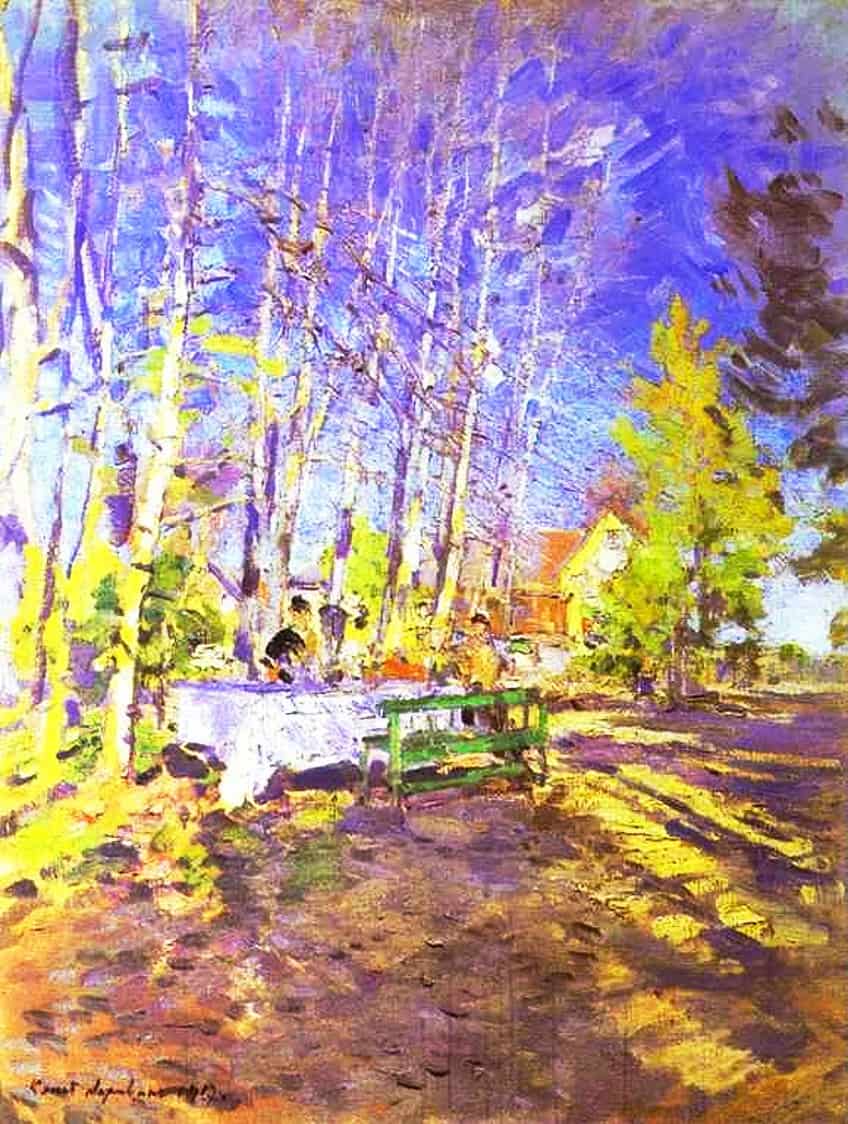
Korovin was also an international set designer for many theaters across Asia, Europe, Australia, and America. Coupled with the Russian use of bold color, which was more popular in Russia than in Paris at the time, Korovin illustrates a combination of cultural painting styles in Spring (1917).
From Impressionism to Post-Impressionism
The French Impressionist group held a total of eight shows between 1874 and 1886, which gradually declined in popularity even to the opinions of some of the pioneering members. Following 1886, many solo exhibitions and smaller group shows were held to help the artists narrow in on their own artistic journeys and development of style. Despite the Impressionists going their separate ways, many artists retained their lifelong friendships with each other except Edgar Degas who became a staunch anti-Semite and stopped associating with Pissarro.
From the original group of revolutionaries, Monet was the last surviving elder who passed away in 1926.
The beginnings of Impressionism also meant the emergence of artists taking an independent stance from the traditions of the academy and Salon. The branch away from the wider path of preferences in art style allowed for the individualistic growth of many Impressionist masters. Following Impressionism, post-Impressionism later developed as a further move away from what Impressionism merely touched the surface on.

Post-Impressionism made clear the line between a fleeting joyful representation and an intentional drive towards modernity, clever use of painting techniques, and other art movements such as Cubism, Neo-Impressionism, Expressionism, and Modernism. It is also important to remind yourself that Impressionism resulted from the cultural and social changes in Europe at the time, which helped outline the ideology of Impressionism itself.
Most Impressionists witnessed the tumultuous effects of the Revolution and Napoleon’s rule, which cast a shadow of change across European culture.
During this period, other theories surrounding the perception of color in light of the subjective experience of color influenced the budding Impressionists and were the backbone of their ideology and use of color. The Impressionists also co-existed with the introduction of photography and the rise of the industrial society that impacted the subject matter of Impressionist artworks. Impressionism captured the change as it happened through cafe scenes, social events, and scenes depicted en Plein air. Color was added back into the real and the superficial facade of perfection faded.
Impressionism as an art movement had a tremendous impact on the way that art was to be studied and understood. Other important Impressionist artists to look at include works by Marie Bracquemond, Gustave Caillebotte, William Merritt Chase, Charles Conder, Armand Guillaumin, and Childe Hassam. Impressionism can also be seen in the sculptural work of Auguste Rodin and French filmmakers Abel Gance and Germaine Dulac.
Frequently Asked Questions
What Is Impressionism?
Impressionism refers to the French art movement of the 19th century that marked the turning point of art preferences from academic and realistic depictions of specific historical and mythological subject matter to the impressionistic depiction of contemporary subjects, landscapes, and daily life.
What Are the Characteristics of an Impressionist Painting?
The characteristics of an Impressionist painting include clear and visible brush strokes, vivid colors, and an emphasis on light, contrast, and movement as opposed to detail and complete scenes. Impressionist paintings carry an unfinished nature and unrealistic color palettes.
Who Started Impressionism?
While fragments of early forms of Impressionism can be seen in other preceding artists, Camille Pissarro is the father of Impressionism and Claude Monet is considered the founder of Impressionism as a formal group of artists to push Impressionistic values. The group of artists also included Edgar Degas, Pierre-Auguste Renoir, Frédéric Bazille, Gustave Caillebotte, Paul Cézanne, Mary Cassatt, Armand Guillaumin, Édouard Manet, Berthe Morisot, and Alfred Sisley.
Jordan Anthony is a Cape Town-based film photographer, curator, and arts writer. She holds a Bachelor of Art in Fine Arts from the University of the Witwatersrand, Johannesburg, where she explored themes like healing, identity, dreams, and intuitive creation in her Contemporary art practice. Jordan has collaborated with various local art institutions, including the KZNSA Gallery in Durban, the Turbine Art Fair, and the Wits Art Museum. Her photography focuses on abstract color manipulations, portraiture, candid shots, and urban landscapes. She’s intrigued by philosophy, memory, and esotericism, drawing inspiration from Surrealism, Fluxus, and ancient civilizations, as well as childhood influences and found objects. Jordan is working for artfilemagazine since 2022 and writes blog posts about art history and photography.
Learn more about Jordan Anthony and about us.
Cite this Article
Jordan, Anthony, “Impressionism – Discover the French Impressionism Art Movement.” artfilemagazine – Your Online Art Source. September 19, 2022. URL: https://artfilemagazine.com/impressionism/
Anthony, J. (2022, 19 September). Impressionism – Discover the French Impressionism Art Movement. artfilemagazine – Your Online Art Source. https://artfilemagazine.com/impressionism/
Anthony, Jordan. “Impressionism – Discover the French Impressionism Art Movement.” artfilemagazine – Your Online Art Source, September 19, 2022. https://artfilemagazine.com/impressionism/.



